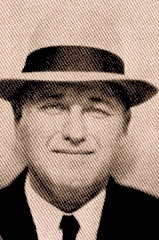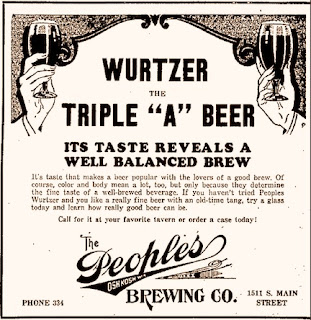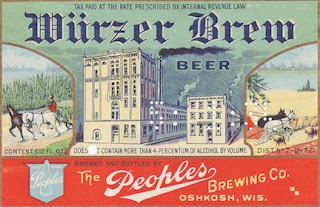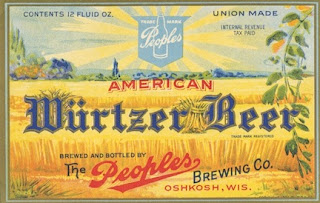A New Beginning
In April 1933, Peoples Brewing Company of Oshkosh celebrated its 20th Anniversary. And they were starting over. National Prohibition, which had kept them from brewing for the previous 14 years, was coming to an end. At Peoples, they decided the time was right to make a break with their more immediate past. The beers they had been producing before Prohibition, Aristo and Asterweiss, were abandoned in favor of a new brew that harkened further back to the German heritage of the brewery’s founders. Those men were now gone, but the brewery’s new flagship beer would have pleased them.
Stier’s Beer
 |
| Joseph Stier |
 The traditional beer of the city of Würzburg in the Franconia region of Northern Bavaria was malty, full-bodied and slightly sweet with a subdued hop character. Stier’s Würtzer Brew was an American take on the style; perhaps drier and lighter in body, but still defined by its malt character. Early advertising for the beer played up its connection to the past. “The BEER WITH A RECORD,” one ad barked. “You will find in WURTZER BREW all the zest, sparkle and life of the finest of old time good beer. It’s properly aged and brewed by our master brewer who knows how.”
The traditional beer of the city of Würzburg in the Franconia region of Northern Bavaria was malty, full-bodied and slightly sweet with a subdued hop character. Stier’s Würtzer Brew was an American take on the style; perhaps drier and lighter in body, but still defined by its malt character. Early advertising for the beer played up its connection to the past. “The BEER WITH A RECORD,” one ad barked. “You will find in WURTZER BREW all the zest, sparkle and life of the finest of old time good beer. It’s properly aged and brewed by our master brewer who knows how.”Joseph Stier died in 1941, but the brewers who followed in his wake at Peoples appear to have held true to the original conception of his beer. The name, though, had to go. Adolph Hitler’s coming to power in Germany coupled with the rise of Americanism in the 1930s rendered associations to the Old World less appealing. At Peoples, the fist tentative steps at altering the name of their brew began in 1935, when the labels were changed to read American Würtzer. Over the coming decade, the prominence of the word Würtzer was diminished until it finally disappeared completely. By 1945, it was known simply as Peoples Beer. And so it would remain until the brewery closed in 1972.
Drinking Peoples Beer
 Drawing a bead on the flavor of a beer that’s been out of production for more than 40 years can be difficult. But in the case of Peoples Beer, enough information has survived to give us a trustworthy profile of its appearance and flavor. A typical Peoples Beer would have poured with a thick creamy head over a golden body of sparkling and very clear beer. The color was a shade darker than most of the premium lagers that are available today. The aroma would have been dominated by grainy malt backed with a light scent of sweet corn and minimal hop aroma. The flavor was mild, yet satiating with the predominate flavors supplied by six-row malt and corn. Hops were primarily used to balance the sweetness and not as a prominent flavor component. It was a highly carbonated beer that – coupled with the light sulfur notes form its yeast – would have given the beer an appreciable finishing bite. Overall, the beer received consistently high ratings from those who analyzed it. A 1971 report by
Drawing a bead on the flavor of a beer that’s been out of production for more than 40 years can be difficult. But in the case of Peoples Beer, enough information has survived to give us a trustworthy profile of its appearance and flavor. A typical Peoples Beer would have poured with a thick creamy head over a golden body of sparkling and very clear beer. The color was a shade darker than most of the premium lagers that are available today. The aroma would have been dominated by grainy malt backed with a light scent of sweet corn and minimal hop aroma. The flavor was mild, yet satiating with the predominate flavors supplied by six-row malt and corn. Hops were primarily used to balance the sweetness and not as a prominent flavor component. It was a highly carbonated beer that – coupled with the light sulfur notes form its yeast – would have given the beer an appreciable finishing bite. Overall, the beer received consistently high ratings from those who analyzed it. A 1971 report by J.E. Siebel Sons’, a Chicago-based brewing research group, concisely summed up the beer in its final years noting, “The sample makes an exceedingly good impression in almost every respect.”
Brewing Peoples Beer
 This is a clone recipe for Peoples Beer. Although I’ve been able to locate a brewery inventory, chemical analysis and tasting notes, I’ve yet to be able to find a recipe for the beer that was actually used in the brewhouse. That said, enough information has been found that I feel confident that this recipe can produce a beer that corresponds closely to Peoples Beer. The recipe is based upon percentages and targets, so that it can be tailored to your specific brewing system.
This is a clone recipe for Peoples Beer. Although I’ve been able to locate a brewery inventory, chemical analysis and tasting notes, I’ve yet to be able to find a recipe for the beer that was actually used in the brewhouse. That said, enough information has been found that I feel confident that this recipe can produce a beer that corresponds closely to Peoples Beer. The recipe is based upon percentages and targets, so that it can be tailored to your specific brewing system.Brewing Targets
Malt Bill
- American Six-row: 72%
- Flaked Corn: 24%
- Munich Malt: 4% (15-20 Lovibond, lesser kilned Munich malts will result in a lighter shade of beer. If the darker Munich malts are unavailable, consider either adding a pinch of Dehusked Carafa II or else eliminating the Munich, increasing the percentage of six-row and adding CaraMunich to reach the target SRM).
- Cluster. Use only a bittering addition and keep the IBUs in the 17-18 range.
- Wyeast 2035, American Lager (supposedly sourced from August Schell Brewery of New Ulm, Minnesota).
- A simple infusion mash at 152ºf will suffice. At Peoples they were almost certainly doing a multi-step mash with protein and scarification rests. Personally, I’ve performed multi-step mashing with these malts and found very little, if any, benefit by doing so. Still, it’s fun to do, if you want to get a feel for how they traditionally would have done things at the brewery.
- You’ll need to do a mini mash using six-row and corn. Then build up the remainder of your wort with Briess Golden Light Liquid Malt Extract.
And If You’re Not a Homebrewer?
You’re not entirely out of luck. There’s a good chance that a Peoples Beer clone will be served by one of the members of the Society of Oshkosh Brewers at this year's Brews n' Blues. And it’s likely that a clone of Chief Oshkosh will also be served. It may be the first time in 40 years that people here have had the opportunity to taste two of Oshkosh’s favorite beers side-by-side.







YES! I was justing thinking that for my first experience of homebrewing I would try an Oshkosh Brew! Thanks for this awesome post!
ReplyDeleteCool, Austin, let me know if you need any help tailoring the recipe to you system.
ReplyDeleteI have the last three bottles of Peoples beer that was brewed at the Oshkosh Brewery. just saying, I'd like to find out more information on this.
ReplyDeleteThanks to all